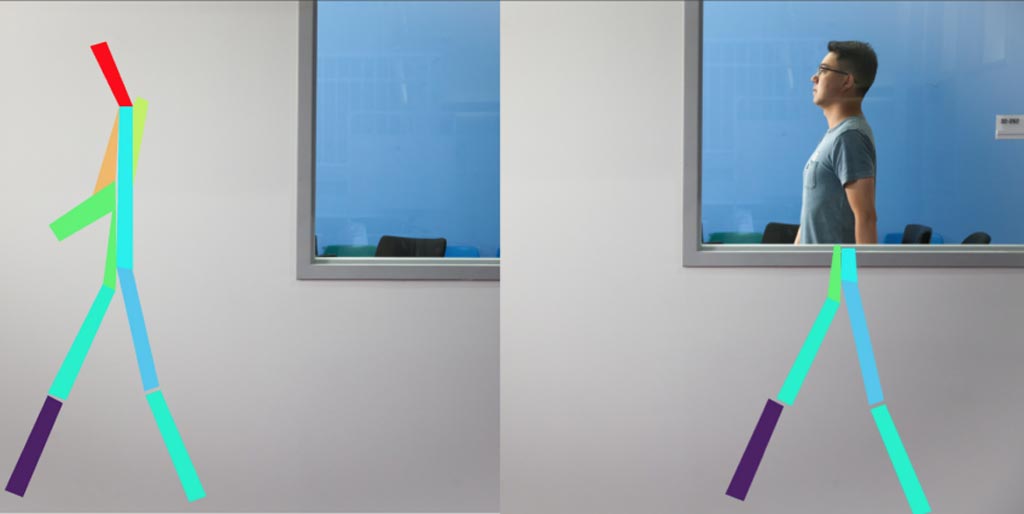AI Study Sees through Walls and Occlusions
|
By HospiMedica International staff writers Posted on 28 Jun 2018 |

Image: A new study shows how artificial intelligence can identify human motion and posture, even through walls (Photo courtesy of CSAIL).
A new study describes how artificial intelligence (AI) can be used to analyze radio signals bouncing off people's bodies so as to study posture and movement, even through walls.
The Massachusetts Institute of Technology (MIT, Cambridge, MA, USA) RF-Pose project is based on a deep neural network approach that parses wireless signals in the WiFi frequencies in order to estimate human poses and postures. One of the stumbling blocks in the process is that teaching AI networks to identify visual patterns relies on human annotation; but since radio signals cannot be annotated, the researchers used a state-of-the-art vision model to provide cross-modal supervision.
This involved collecting thousands of examples of both wireless device data and matched photographic images of people doing activities like walking, talking, sitting, opening doors, and waiting for elevators. They then used the images to extract stick figures, which they showed to the AI neural network along with the corresponding radio signal. The combined data enabled the AI system to learn the association between the radio signal and the stick figures of the people in a given scene. Once trained, the network used only the wireless signal for pose estimation.
The results showed that when tested on visible scenes, the radio-based system is almost as accurate as the vision-based system used to train it. But unlike vision-based pose estimation, the radio-based system can also estimate two-dimensional (2D) poses through walls, despite never being trained on such scenarios. The researchers suggest the system could monitor patients with Parkinson's disease, multiple sclerosis (MS), and other issues, as well as provide an added security for seniors at home by monitoring falls, injuries, and changes in activity patterns. The study was presented at the annual conference on Computer Vision and Pattern Recognition (CVPR), held during June 2018 in Salt Lake City (UT, USA).
“Just like how cellphones and Wi-Fi routers have become essential parts of today's households, I believe that wireless technologies like these will help power the homes of the future,” said senior author Professor Dina Katabi, PhD, of the MIT Computer Science and Artificial Intelligence Laboratory (CSAIL). “We've seen that monitoring patients' walking speed and ability to do basic activities on their own gives healthcare providers a window into their lives that they didn't have before, which could be meaningful for a whole range of diseases.”
Related Links:
Massachusetts Institute of Technology
The Massachusetts Institute of Technology (MIT, Cambridge, MA, USA) RF-Pose project is based on a deep neural network approach that parses wireless signals in the WiFi frequencies in order to estimate human poses and postures. One of the stumbling blocks in the process is that teaching AI networks to identify visual patterns relies on human annotation; but since radio signals cannot be annotated, the researchers used a state-of-the-art vision model to provide cross-modal supervision.
This involved collecting thousands of examples of both wireless device data and matched photographic images of people doing activities like walking, talking, sitting, opening doors, and waiting for elevators. They then used the images to extract stick figures, which they showed to the AI neural network along with the corresponding radio signal. The combined data enabled the AI system to learn the association between the radio signal and the stick figures of the people in a given scene. Once trained, the network used only the wireless signal for pose estimation.
The results showed that when tested on visible scenes, the radio-based system is almost as accurate as the vision-based system used to train it. But unlike vision-based pose estimation, the radio-based system can also estimate two-dimensional (2D) poses through walls, despite never being trained on such scenarios. The researchers suggest the system could monitor patients with Parkinson's disease, multiple sclerosis (MS), and other issues, as well as provide an added security for seniors at home by monitoring falls, injuries, and changes in activity patterns. The study was presented at the annual conference on Computer Vision and Pattern Recognition (CVPR), held during June 2018 in Salt Lake City (UT, USA).
“Just like how cellphones and Wi-Fi routers have become essential parts of today's households, I believe that wireless technologies like these will help power the homes of the future,” said senior author Professor Dina Katabi, PhD, of the MIT Computer Science and Artificial Intelligence Laboratory (CSAIL). “We've seen that monitoring patients' walking speed and ability to do basic activities on their own gives healthcare providers a window into their lives that they didn't have before, which could be meaningful for a whole range of diseases.”
Related Links:
Massachusetts Institute of Technology
Latest AI News
Channels
Critical Care
view channel
CPR Guidelines Updated for Pediatric and Neonatal Emergency Care and Resuscitation
Cardiac arrest in infants and children remains a leading cause of pediatric emergencies, with more than 7,000 out-of-hospital and 20,000 in-hospital cardiac arrests occurring annually in the United States.... Read more
Ingestible Capsule Monitors Intestinal Inflammation
Acute mesenteric ischemia—a life-threatening condition caused by blocked blood flow to the intestines—remains difficult to diagnose early because its symptoms often mimic common digestive problems.... Read more
Wireless Implantable Sensor Enables Continuous Endoleak Monitoring
Endovascular aneurysm repair (EVAR) is a life-saving, minimally invasive treatment for abdominal aortic aneurysms—balloon-like bulges in the aorta that can rupture with fatal consequences.... Read more
Wearable Patch for Early Skin Cancer Detection to Reduce Unnecessary Biopsies
Skin cancer remains one of the most dangerous and common cancers worldwide, with early detection crucial for improving survival rates. Traditional diagnostic methods—visual inspections, imaging, and biopsies—can... Read moreSurgical Techniques
view channel
Robotic Assistant Delivers Ultra-Precision Injections with Rapid Setup Times
Age-related macular degeneration (AMD) is a leading cause of blindness worldwide, affecting nearly 200 million people, a figure expected to rise to 280 million by 2040. Current treatment involves doctors... Read more
Minimally Invasive Endoscopic Surgery Improves Severe Stroke Outcomes
Intracerebral hemorrhage, a type of stroke caused by bleeding deep within the brain, remains one of the most challenging neurological emergencies to treat. Accounting for about 15% of all strokes, it carries... Read morePatient Care
view channel
Revolutionary Automatic IV-Line Flushing Device to Enhance Infusion Care
More than 80% of in-hospital patients receive intravenous (IV) therapy. Every dose of IV medicine delivered in a small volume (<250 mL) infusion bag should be followed by subsequent flushing to ensure... Read more
VR Training Tool Combats Contamination of Portable Medical Equipment
Healthcare-associated infections (HAIs) impact one in every 31 patients, cause nearly 100,000 deaths each year, and cost USD 28.4 billion in direct medical expenses. Notably, up to 75% of these infections... Read more
Portable Biosensor Platform to Reduce Hospital-Acquired Infections
Approximately 4 million patients in the European Union acquire healthcare-associated infections (HAIs) or nosocomial infections each year, with around 37,000 deaths directly resulting from these infections,... Read moreFirst-Of-Its-Kind Portable Germicidal Light Technology Disinfects High-Touch Clinical Surfaces in Seconds
Reducing healthcare-acquired infections (HAIs) remains a pressing issue within global healthcare systems. In the United States alone, 1.7 million patients contract HAIs annually, leading to approximately... Read moreHealth IT
view channel
Printable Molecule-Selective Nanoparticles Enable Mass Production of Wearable Biosensors
The future of medicine is likely to focus on the personalization of healthcare—understanding exactly what an individual requires and delivering the appropriate combination of nutrients, metabolites, and... Read moreBusiness
view channel
Philips and Masimo Partner to Advance Patient Monitoring Measurement Technologies
Royal Philips (Amsterdam, Netherlands) and Masimo (Irvine, California, USA) have renewed their multi-year strategic collaboration, combining Philips’ expertise in patient monitoring with Masimo’s noninvasive... Read more
B. Braun Acquires Digital Microsurgery Company True Digital Surgery
The high-end microsurgery market in neurosurgery, spine, and ENT is undergoing a significant transformation. Traditional analog microscopes are giving way to digital exoscopes, which provide improved visualization,... Read more
CMEF 2025 to Promote Holistic and High-Quality Development of Medical and Health Industry
The 92nd China International Medical Equipment Fair (CMEF 2025) Autumn Exhibition is scheduled to be held from September 26 to 29 at the China Import and Export Fair Complex (Canton Fair Complex) in Guangzhou.... Read more














